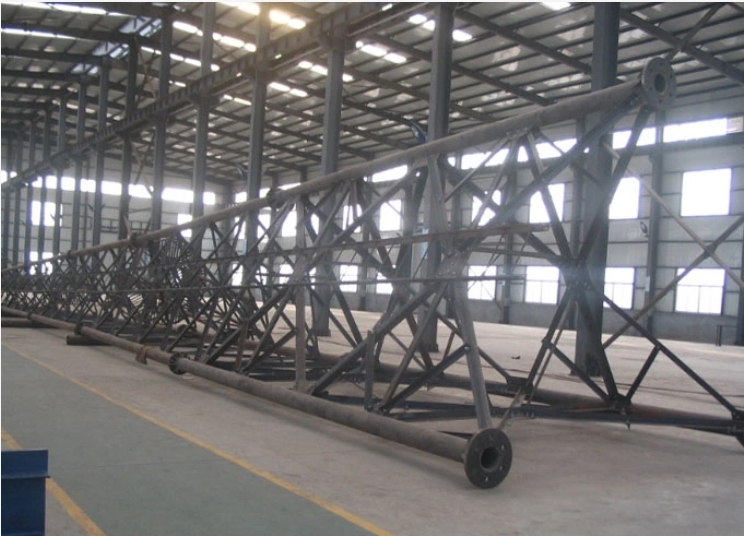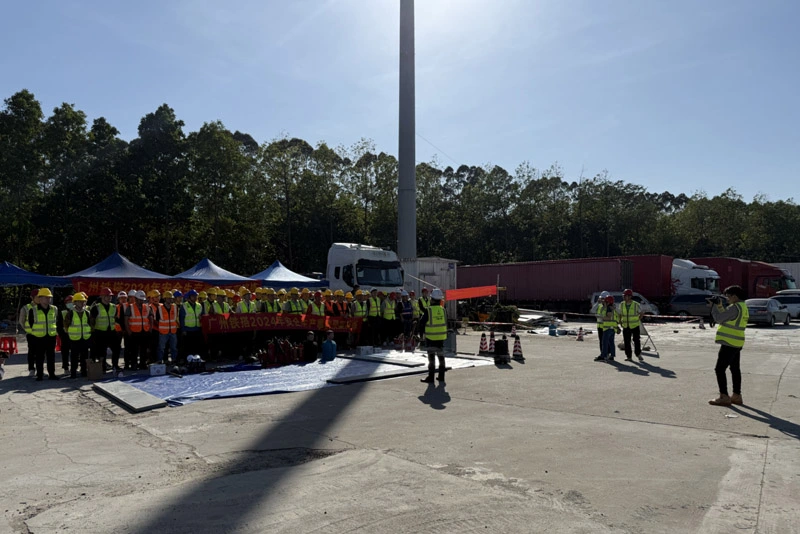Choosing the right tower feels complicated. Balancing technical needs with budget constraints is tough. A 3-legged tower offers a smart solution addressing both structure and cost effectively. You choose a 3-legged antenna tower for its strong triangular structure, good wind resistance, lower material costs, smaller footprint, and easier installation compared to 4-legged towers, especially in certain environments. Making this choice involves looking closely at the technical benefits and the economic savings. As manufacturers at Junjiang Construction, we see clients weigh these factors daily. Let's break down why the 3-legged design is often a very practical and efficient option for communication needs. It's more than just one less leg; it's about smart engineering.
Worried about tower stability in windy conditions? You need a design that handles stress well. The 3-legged tower uses basic geometry for impressive strength and wind handling. The triangular base of a 3-legged tower provides inherent stability. Forces are distributed efficiently among the legs. This design often presents less surface area to wind, reducing overall wind load compared to four-legged structures.
In engineering, the triangle is known as the most stable basic shape. You cannot distort a triangle without changing the length of its sides. A 3 legged antenna tower uses this principle directly. Its base forms a triangle, creating a very rigid foundation. Any force applied to the tower, whether from wind or the weight of antennas, gets distributed down through these three legs to the ground anchors. My experience shows this natural stability is a key reason for its reliability. Unlike a square base (like in a 4-legged tower), which can potentially rack or twist if not properly braced, the triangle holds its shape inherently. This means the structure is naturally good at resisting twisting forces, which are common under wind load.
Wind force is a major consideration for any tower. A 3-legged tower often presents a smaller profile to the wind compared to a similar capacity 4-legged tower. Think about it: there's one less leg and potentially less bracing material creating obstruction. Less obstruction means the wind flows around the tower more easily, putting less overall pressure, or drag, on the structure. We calculate wind loads very carefully based on location and tower height. Often, the calculations show a noticeable reduction in load for the 3-legged design, especially for certain wind directions. This allows for a potentially lighter, yet still safe, structure. Here's a simple comparison:
| Feature | 3-Legged Tower | 4-Legged Tower |
|---|---|---|
| Base Shape | Triangle (inherently rigid) | Square (needs more bracing) |
| Force Distribution | Efficiently shared among 3 points | Shared among 4 points |
| Typical Wind Area | Often Lower | Often Higher |
| Twisting Resistance | Naturally High | Relies heavily on bracing |
This structural efficiency makes the 3-legged tower a technically sound choice for many communication applications we encounter.
Need to build a reliable network without breaking the bank? Material and installation costs add up quickly. The 3-legged tower design by telecom tower factory offers significant economic advantages. Using one less leg and typically less bracing directly reduces the amount of steel needed. This lowers material costs. A smaller foundation and simpler assembly also cut construction time and expenses.

This is the most direct saving. A 3-legged tower simply uses less structural steel compared to a 4-legged tower designed for similar height and load capacity. Fewer main leg members and often less secondary bracing material translate directly into a lower purchase price for the tower components. Steel is priced by weight, so any reduction makes a difference. In my years at Junjiang Construction, I've seen clients achieve notable savings right from the start just based on the reduced steel tonnage. This is especially true for large projects involving multiple towers.
Fewer legs mean fewer points transferring load to the ground. This often allows for a smaller and potentially less complex foundation design. Excavation, concrete, and reinforcing steel costs for the foundation can be substantial. Reducing the foundation size saves on all these aspects. The specific foundation design depends heavily on soil conditions, but generally, a 3-legged tower requires less ground preparation and materials than a 4-legged one. This can be a big advantage, especially in remote areas or locations with difficult soil.
Fewer components usually mean quicker assembly. Erecting a 3-legged tower can be faster and require less complex lifting equipment compared to a 4-legged tower. Fewer connection points need to be bolted. This reduction in installation time saves on labor costs and equipment rental fees. Faster deployment also means the communication network can become operational sooner, which is often a critical business factor. We design our towers for efficient field assembly, and the 3-legged configuration inherently supports this goal. Consider the typical cost factors:
| Cost Component | 3-Legged Tower Impact | 4-Legged Tower Impact |
|---|---|---|
| Steel Material | Lower | Higher |
| Foundation | Smaller / Less Complex | Larger / More Complex |
| Transportation | Potentially Lighter/Fewer Loads | Potentially Heavier/More Loads |
| Installation Labor | Lower | Higher |
| Equipment Rental | Potentially Lower | Potentially Higher |
These economic benefits make the 3-legged tower a very attractive option from a budget perspective.
Is space limited, or is the terrain challenging? Not every location is ideal for a large structure. The 3-legged tower's design offers unique advantages in certain deployment scenarios. Their smaller footprint makes 3-legged towers ideal for tight spaces like urban rooftops or narrow land plots. They are also often easier to install on uneven or difficult terrain.
In crowded urban areas or on existing building rooftops, space is often at a premium. A 3-legged tower requires less ground area for its base and foundation compared to a 4-legged tower. This smaller footprint can be the deciding factor when choosing a tower for a site with limited available space. We frequently supply towers for rooftop installations where minimizing the occupied area and the load on the existing structure is critical. The triangular base fits more easily into corners or irregular spaces that might not accommodate a square base.
Installing towers in mountainous regions or areas with very uneven ground presents unique challenges. Leveling a site for a large square foundation can require significant excavation and earthmoving. The 3-point foundation of a 3-legged tower can sometimes adapt more easily to slopes or uneven surfaces. While proper foundation engineering is always essential, the geometry might allow for less site disruption and easier anchoring on difficult terrain compared to stabilizing four points on uneven ground. This makes it a practical choice for extending networks into more remote or geographically complex areas.
While structurally sound, 3-legged towers are often considered most efficient for light to moderate antenna loads and in areas without extremely high wind speed requirements. For very heavy antenna arrays or regions known for hurricane-force winds, a heavier-duty 4-legged tower might be specified for its potentially greater overall load capacity and stiffness, despite the higher cost. However, for typical cellular, microwave, or wireless broadband applications in most geographic locations, the 3-legged design provides more than adequate strength and stability, hitting a sweet spot between performance and economy. We always help clients assess their specific load and environmental requirements to recommend the most suitable tower type.
Thinking about long-term investments? Tower technology isn't static. Innovations continue to improve the design and application of 3-legged towers, ensuring their relevance moving forward. Future trends include using lighter, stronger materials, integrating smart monitoring sensors, developing more modular designs for easier upgrades, and focusing on aesthetics for better environmental integration.

While steel remains the primary material, research into using alternative or composite materials could lead to even lighter and potentially more corrosion-resistant towers in the future. Think about fiber-reinforced polymers or advanced alloys. Alongside materials, computer-aided design (CAD) and finite element analysis (FEA) software allow engineers like us at Junjiang Construction to refine the structural design continuously. We can optimize member sizes and connection details more precisely than ever before, pushing the boundaries of efficiency while maintaining safety margins. This leads to towers that are strong yet use material very effectively.
The concept of "smart infrastructure" is growing. Future towers might incorporate integrated sensors to monitor their structural health in real-time. These sensors could track stress, vibration, tilt, or corrosion levels. This data could allow for predictive maintenance, identifying potential issues before they become serious problems and optimizing inspection schedules. Imagine a tower that tells you when it needs attention! This could significantly improve long-term reliability and reduce lifetime maintenance costs.
As communication needs evolve rapidly (think 5G and beyond), towers need to be adaptable. We are seeing a trend towards more modular designs. This means towers could be assembled from standardized sections, making initial installation faster and future upgrades or equipment changes easier. Instead of replacing an entire tower, sections could potentially be added or swapped out. Furthermore, especially in urban or scenic areas, there's increasing demand for towers that blend better with their surroundings. Future designs might incorporate more aesthetic elements, camouflage techniques, or multi-functional capabilities (like combining lighting or advertising space) to minimize visual impact. We are always exploring ways to make our towers both functional and visually acceptable.
Choosing a 3-legged antenna tower offers a smart balance of structural strength, wind resistance, and significant cost savings due to lower material use and easier installation, especially in space-constrained environments. As a leading manufacturer of steel towers, Junjiang Construction Co., Ltd. offers the 3-Legged Communication Tower, a pivotal structure in enhancing communication networks. These towers elevate antennas, ensuring optimal signal transmission for microwave, ultra-short wave, and wireless networks.
